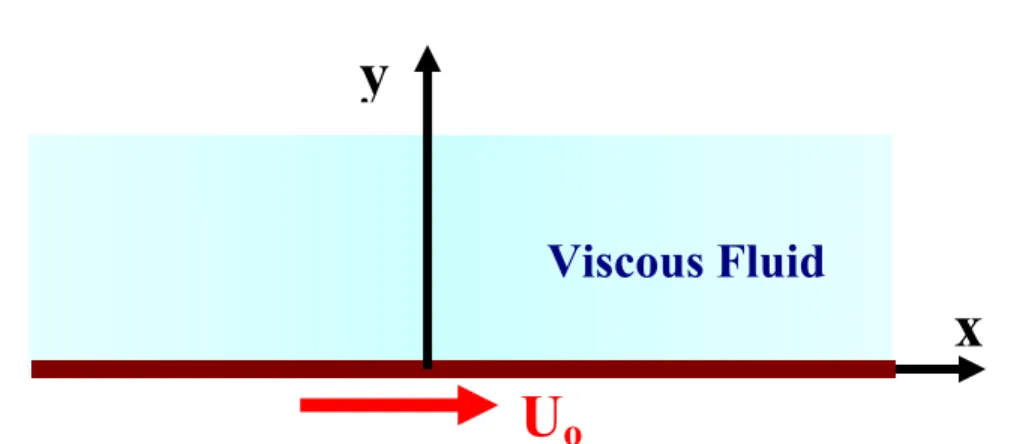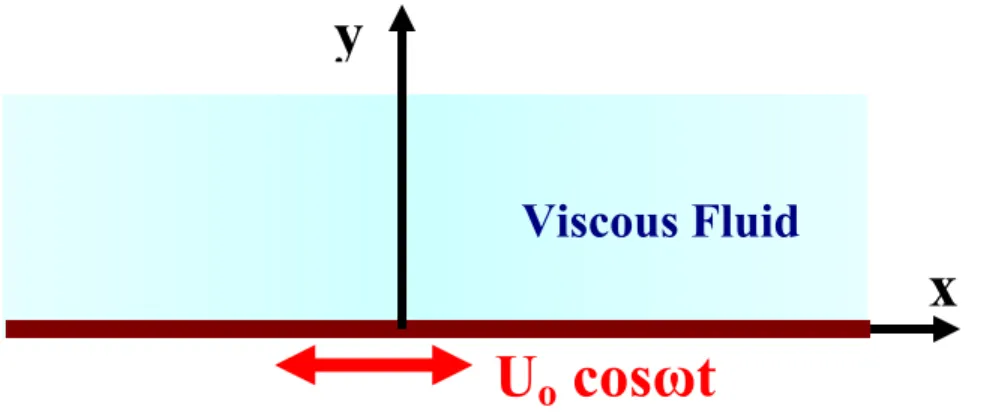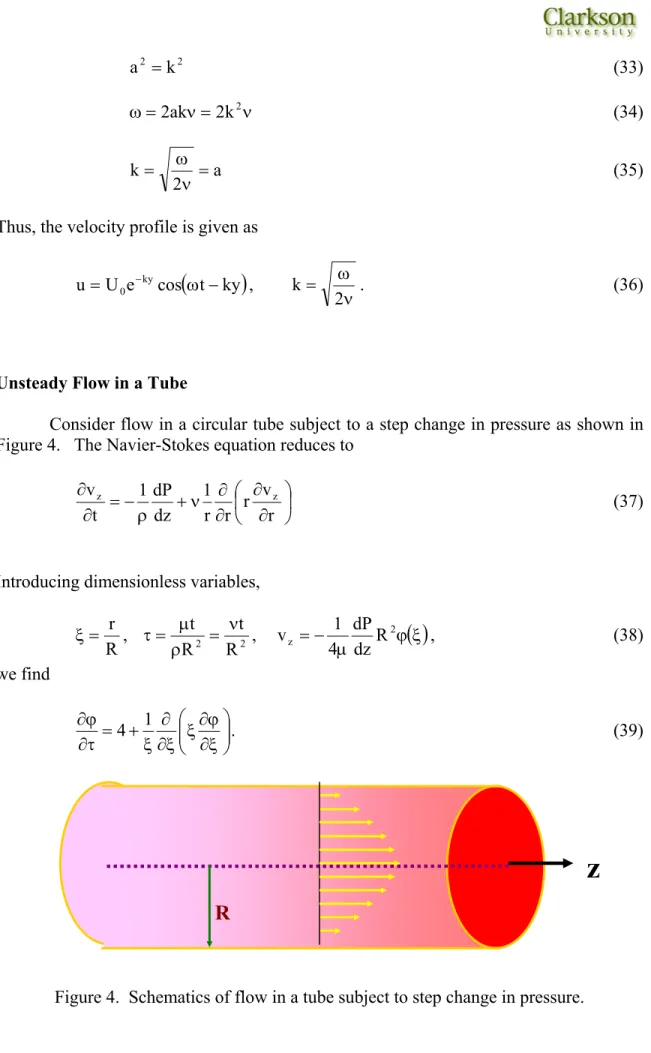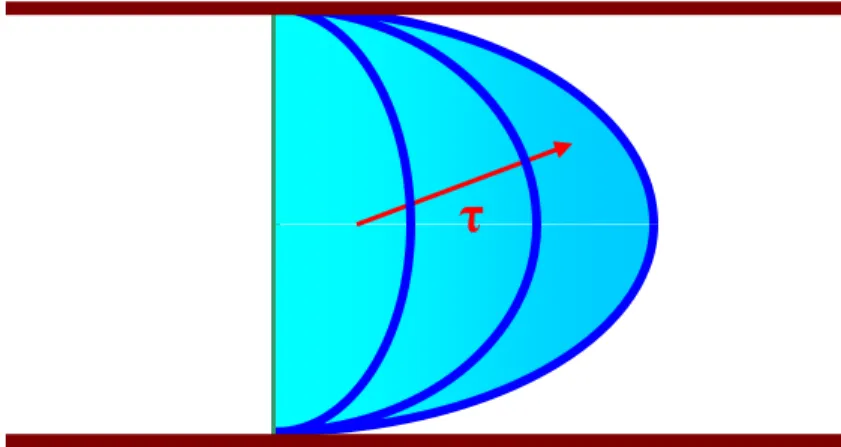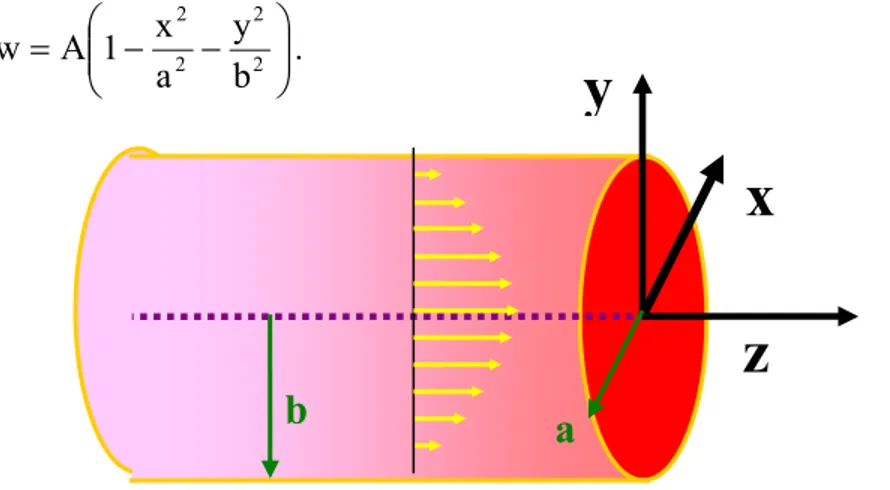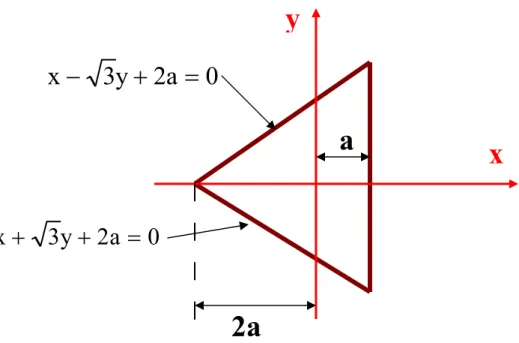Exact Solutions to the Navier-Stokes Equation
Unsteady Parallel Flows (Plate Suddenly Set in Motion)
Consider that special case of a viscous fluid near a wall that is set suddenly in motion as shown in Figure 1. The unsteady Navier-Stokes reduces to
2 2
y u t
u ∂ ∂ ν = ∂ ∂
(1)
U
oViscous Fluid
y
x
Figure 1. Schematics of flow near a wall suddenly set in motion. The boundary conditions are:
At y=0 u=U0 (2)
at y=∞, u=0 (3)
The corresponding initial condition for the fluid that starts from rest is given as
at t =0 u=0. (4)
Similarity Solution (Group Theory)
Let
, (5)
1
t ~
t , y~ta
Equation (1) implies that
,
a 2
Thus,
2 1
t ~
y (7)
Now introducing the similarity variables
t 2
y ν =
η , =f
( )
η Uu
0
, (8)
we find t 2 1 u y u ν η ∂ ∂ = ∂ ∂ , t 4 1 u y u 2 2 2 2 ν η ∂ ∂ = ∂ ∂ (9) t 2 u t 2 1 t 2 y u t u η η ∂ ∂ − = − ν η ∂ ∂ = ∂ ∂
. (10)
Substituting (9) and (10) in Equation (1), we find
t 4 1 f t 2 f ν ′′ ν = η ′
− , (11)
or
0 f 2
f ′′+ η ′= (12)
Boundary and initial conditions (2)-(4) in terms of the similarity variables become 1
) 0 (
f = , f(∞)=0. (13)
From Equation (12), it follows that η − = ′ ′′ 2 f f
, or lnf′=lnc−η2 (14)
or
, and , (15)
2 ce
f′= −η f c e d 1
0 1
2
1 η +
where the first boundary condition in (13) is used. The second boundary condition implies that
( )
∫
∞ −ηη +
= = ∞
0 e d 1
c 1 0
f 21 or
π − = η −
∫
∞ −η2
d e
1
0 1
2 1
=
c (16)
Equation (15) then becomes
( )
η − = η π−
=
∫
η −ηerf 1 d e 2 1 f
0 1
2
1 (17)
or
η =erfc
f ,
ν =
t 2
y erfc U
u 0 (18)
Time variations of the velocity profile as predicted by Equation (18) are shown in Figure 2.
Transform Method
0
0.0
0.2
0.4
0.6
0.8
1.0
u/Uo
0.5
1
1.5
2
2.5
3
y
Figure 2. Time variations of velocity profile.
tν=4
tν=1
tν =0.25
An alternative is to use the transform method. Taking Laplace transform of Equation (1), it follows that
2 2
y u u
s
∂ ∂ ν
= (19)
or
0 u s
u =
ν − ″
(20)
The solution to (20) is
y s y
s
Be Ae
u= − ν + ν (21)
Boundary conditions (2) and (3) imply that
s U
A= 0 , B=0 (22)
Thus, the solution in the transform domain is given by
y s 0 e
s U
u= − ν (23)
Inverse Laplace transform of (23) gives
ν =
t 2
y erfc U
u 0 . (24)
Oscillating Plate
Consider that case of a viscous fluid near an oscillating wall as shown in Figure 3. The unsteady Navier-Stokes reduces to
2 2
y u t
u ∂ ∂ ν = ∂ ∂
U
ocos
ω
t
Viscous Fluid
y
x
Figure 2. Schematics of flow near an oscillating wall. The boundary conditions are:
t at cos
U
u= 0 ω y=0 (26)
at
0
=
u y=∞ (27)
Let
(
t ay cose U
u= 0 −ky ω −
)
. (28)Then
(
t ay sine
U
)
t
u ky
0 ω −
ω − = ∂
∂ −
(29)
(
)
(
(
kcos t ay asin t ay eU y
u ky
0 − ω − + ω −
= ∂
∂ −
))
(30)
(
θ− θ− θ= ∂
∂ −
cos a sin ka 2 cos k e U y
u ky 2 2
0 2 2
)
, ayθ=ωt− (31)Substituting (29)-(31) into Equation (25) it follows that
(
)
(
− θ− θ)
ν = θ ω
− sin k2 a2 cos 2aksin (32)
2 2
k
a = (33)
ν = ν =
ω 2
k 2 ak
2 (34)
a 2
k =
ν ω
= (35)
Thus, the velocity profile is given as
(
t ky)
cos e U
u= 0 −ky ω − ,
ν ω =
2
k . (36)
Unsteady Flow in a Tube
Consider flow in a circular tube subject to a step change in pressure as shown in Figure 4. The Navier-Stokes equation reduces to
∂ ∂ ∂
∂ ν + ρ − = ∂ ∂
r v r r r 1 dz dP 1 t
vz z
(37)
Introducing dimensionless variables,
R r =
ξ , 2 2
R t R
t ν
= ρ
µ =
τ , ϕ
( )
ξµ −
= 2
z R
dz dP 4
1
v , (38)
we find
ξ ∂
ϕ ∂ ξ ξ ∂
∂ ξ + = τ ∂
ϕ
∂ 1
4 . (39)
R
z
The boundary condition is
0 at , (40)
=
ϕ ξ=1
with the initial conditions
0 at . (41)
=
ϕ τ=0
Let
, (42)
ψ − ξ − =
φ 2
1
Equation (39) reduces to
ξ ∂
ψ ∂ ξ ξ ∂
∂ ξ = τ ∂
ψ
∂ 1
(43)
The boundary and initial conditions (40) and (41) now become
At ξ=1, ψ =0. (44)
At τ=0, ψ =1−ξ2. (45)
To find the solution the method of separation of variable is used. That is let
(46)
( ) ( )
ξ τ =ψ F T
Equation (43) then becomes
2
d dF d
d F
1 T
T =−α
ξ ξ ξ ξ = &
. (47)
From Equation (47), it follows that
0 , (48)
0 F d dF d F
d 2 2
2 2
2 +α ξ =
ξ ξ + ξ
ξ . (49)
The solutions to Equations (48) and (49) are given as
(50) τ α − = 2 Ce T
, (51)
( )
αξ +(
αξ =AJ0 BY0F
)
)
)
where J0
(
αξ and Y0(
αξ are Bessel function of first and second kind of zeroth order. The boundary conditions aresince
( )
0 ~finite B 0F ⇒ = Y0
( )
0 →∞. (52)and
. (53)
( )
1 0 J( )
0F = ⇒ 0 α =
Equation (53) is a characteristic equation. The corresponding eigenvalues, αn, are given as
405 . 2
1 =
α , α2 =5.52, α3 =8.654,… (54)
The general solution for Equation (43) then is given by
(55)
(
∑
α ξ=
ψ −ατ
n
n 0
ne J
A 2n
)
)
Using the initial condition
(55)
(
∑
α ξ = ξ − n n 0 n 2 J A 1 then(
)
( )
( )
( )
( )
n 2 1 3 n n 1 1 0 n 2 0 10 0 n
2 n J 5 . 0 / J 4 d J d J 1 A α α α = ξ ξ α ξ ξ ξ α ξ ξ − =
∫
∫
(56) or( )
n1 3 n n J 8 A α α
= . (57)
( )
( )
∑
α αα ξ=
ψ −ατ
n 1 n
3 n
n 0
J J e 8
2 n
, (58)
and
( )
( )
∑
−ατα α
ξ α −
ξ − = ϕ
n 1 n
3 n
n 0
2 e n
J J 8
1 (59)
Variation of the velocity profile in the pipe is shown schematically in Figure 5.
Figure 5. Variations of velocity field in a tube subject to a step change in pressure.
Noncircular Pipe Flows
Consider steady state viscous flows in a pipe with arbitrary cross section under a constant pressure gradient as shown in Figure 6. The Navier-Stokes equation is given as
const dz
dP 1 W
2 =
µ =
∇ . (60)
The corresponding boundary condition is
on S. (61)
0 W=
S
Figure 6. An arbitrary cross-section pipe subject to a constant pressure gradient.
Elliptical Pipes
Consider an elliptical cross-section pipe shown in Figure 7 with its boundary given as
1 b y a
x 2 2 =
+
. (62)
We assume that the velocity field is given by
− −
= 22 22
b y a x 1 A
w . (63)
a
y
x
z
b
(
)
dz dP 1 b
a b a A 2 b
2 a
2 A
w 2 2
2 2 2
2 2
µ = + −
=
+
− =
∇ (64)
Hence
− − +
µ −
= 22 22 22 22
b y a x 1 b a
b a dz dP 2
1
A (65)
The flow rate is given as
. (66)
∫∫
= wdxdy
Q
After integration, it follows that
2 2
3 3
b a
b a dz dP 4 Q
+ µ
π −
= . (67)
Triangular Pipes
Consider a pipe as shown in Figure 8 whose cross section is an equilateral triangle. The equation of the section is given as
( ) (
x,y x a)
(
x 3y 2a)(
x 3y 2a)
0f = − − + + + = . (68)
Assuming
(69)
(
x,y Afw=
)
Then
( )
dz dP 1 aA 12 y , x f A
w 2
2
µ = =
∇ =
0
a
2
y
3
x
+
+
=
0
a
2
y
3
x
−
+
=
2a
a
y
x
Figure 8. A triangular pipe subject to a constant pressure gradient.
Thus,
dx dP a 12
1 A
µ
= (71)
Hence,
(
x a)
(
x 3y 2a)(
x 3y 2a)
dxdP a 12
1
w − − + + +
µ
